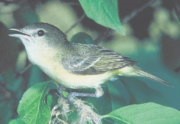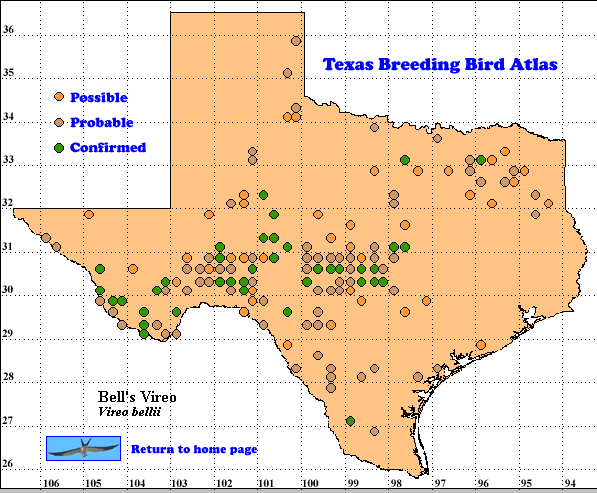The Bell’s Vireos, fairly nondescript neotropical migrants, nest in the central and southwestern United States and northern Mexico. Over much of their former range, including parts of Texas, they have declined rapidly in the past several decades and are now rare to locally uncommon. Despite a few old winter reports from the lower Rio Grande Valley (Oberholser, 1974), they winter primarily on the Pacific coast of Mexico and northern Central America.
Although their plumage is rather plain, their song is a very distinctive and easily recognizable cheedle cheedle cheedle chee?, cheedle cheedle cheedle chew! This characteristic song, and their habit of singing throughout the day usually makes them easy to locate. However, their tendency to remain in dense, impenetrable vegetation often makes them difficult to see, as well as to confirm nesting. Only 22.5% of the TBBA records were actually confirmed with eggs or young.
DISTRIBUTION: According to TBBA data (1987-1992), the Bell’s Vireo has a very local distribution in Texas, primarily in the central portions of the state. The largest concentrations appeared in central Texas, from the Edwards Plateau west to the Trans-Pecos and Big Bend National Park. Elsewhere, they occurred in low densities, especially in south Texas, the eastern edge of the Panhandle and the Coastal Prairies. There was, however, a cluster of records from northeast Texas, where this species is very locally distributed, but possibly increasing (pers. obs.).
SEASONAL OCCURRENCE: In the desert southwest Bell’s Vireos begin arriving on breeding grounds in early or mid-March (Wauer, 1996). while in north Texas they arrive a little later, usually in mid- to late April or early May. Oberholser (1974) lists extreme dates for eggs as March 20 through August 6. Most of the TBBA confirmed nesting records with available dates, were from mid-May through mid-June. The clutch typically consists of four eggs, although three or even five have been noted. Incubation lasts fourteen days, and it usually takes the young about eleven days to fledge (Bent, 1950). Singing diminishes in late August, although sometimes continues into September. Most Bell’s Vireos leave the state by late September or early October.
BREEDING HABITAT: In Texas, as elsewhere, Bell’s Vireos nest in a variety of early successional habitats, often near water, where dense understory vegetation is present. They are generally absent from open deserts, mature woods or pure grasslands (Brown, 1993). In the desert southwest they frequently inhabit mesquite-associations along floodplains or in willow thickets along streams, while in other parts of the state they seem to prefer upland thickets in abandoned fields or pastures.
In Big Bend National Park this species is one of the most abundant residents along the Rio Grande floodplain (Wauer, 1996). In the Concho Valley, on the northwest edge of the Edwards Plateau, Bell’s Vireos are common in mesquite brushlands, with most breeding birds inhabiting “…hackberry thickets along draws with intermittent pools of water” (Maxwell, 1979). In the Edwards Plateau they are uncommon in abandoned pastures and fields where dense invasive thickets are present (Lockwood 2001). In northeast and north-central Texas, they are rare to locally uncommon in dense upland thickets of persimmon, sumac, plum, sugarberry and rough-leaf dogwood, especially in abandoned cattle pastures, along brushy fence rows, railroad right-of-ways or anywhere that human neglect creates suitable habitat. In available habitat, especially in the vicinity of a cattle pond or other source of water, several pairs occur in a small area (James and Neal, 1986; pers. obs.).
Like the nests of other vireos, the small cup-shaped nest is usually suspended from a small fork, often no more than one to three feet above ground, although in Big Bend they have been reported as high as 12 feet (Wauer, 1996).
STATUS: Constantly changing land practices in many parts of the state are both beneficial and detrimental to this small neotropical migrant. In most areas, Bell’s Vireos benefit from idle land that is allowed to “grow up.” However, as the habitat matures, they are forced to move on. As a result, brush clearance, such as along fence rows and rural county roads, removes prime habitat for this species. Perhaps the most distressing enemy of this small vireo is the Brown-headed Cowbird (Molothrus ater), a brood parasite which has increased alarmingly in the past century. Cowbirds lay their eggs in the nests of other birds, and open country species such as the Bell’s Vireo are prime targets for these avian marauders (Phillips, 1991). As a result, many Bell’s Vireo parents probably succeed in raising only cowbird young.
Compared with breeding data from Oberholser (1974), the TBBA data indicate that Bell’s Vireos have declined in many areas, most noticeably in south Texas and the lower Texas coast, as well as west-central Texas, north-central Texas and the Panhandle. According to Pulich (1988) and Phillips (1991) they are now rare in many regions where they were once considered abundant.
TBBA data suggest that the Bell’s Vireo’s remaining stronghold stretches from Big Bend National Park, where they are “abundant” (Wauer, 1996) to the Concho Valley, where they are “common” (Maxwell, 1979) east to the Edwards Plateau, where they are “uncommon” (Lockwood 2001). Interestingly, similar results were obtained by the Breeding Bird Survey from 1970-1989 (Price, et al, 1995).
It is also of interest to note that the TBBA uncovered evidence that the Bell’s Vireo may be slightly more common in portions of northeast Texas than they were in the past. In fact, it appears that the atlas project documented the early stages of a rebound in the northern Blackland Prairie and the Post Oak Savannah. Curiously, a local decline in agriculture may have created the brushy habitat that Bell’s Vireos utilize (pers. obs.). This trend appears to have continued following the completion of the TBBA. Subsequent fieldwork in Delta, Fannin and Lamar counties, each of which Oberholser (1974) listed either questionable, or no historical records, has revealed large areas of seemingly suitable habitat. As a result, following the TBBA field work (1097-1992), Bell’s Vireos have become uncommon, yet fairly widespread, in these counties (pers. obs.).
On the central Texas coast, where they have never been very common (Oberholser, 1974) there were a few scattered sightings during the study period. They remain absent from the Piney Woods of deep east Texas and from the High Plains in the extreme northwestern portions of the Panhandle.
Text by Matt White (posted with updates 2006)
Literature cited.
Bent, A.C. 1950. Life histories of North American birds. Wagtails, shrikes, vireos, and their allies. U. S. Nat. Mus., Washington, DC.
Brown, B. T. 1993. Bell’s Vireo (Vireo bellii). In The birds of North America, No. 35 (A. Poole and F. Gill, eds.). The Birds of North America, Inc., Philadelphia, PA.
James, D. A. and J. C. Neal. 1986. Arkansas Birds: Their status and abundance. University of Arkansas Press, Fayetteville.
Lockwood, M. W. 2001. Birds of the Texas Hill Country. University of Texas Press, Austin.
Maxwell, T. 1979. Vireos (Aves: Vireonidae) in West-Central Texas. Southwest. Nat. 24: 223-229.
Oberholser, H. C. 1974. The bird life of Texas. University of Texas Press, Austin.
Price, J., S. Droege and A. Price. 1995. The summer atlas of North American birds. Academic Press, San Diego, CA.
Phillips, A. R. 1991. The known birds of North and Middle America, part 2. A. R. Phillips, Denver, CO.
Pulich, W. 1988. The birds of north central Texas. Texas A&M University Press, College Station.
Wauer, R. H. 1996. A field guide to birds of the Big Bend. Gulf Publishing, Houston, TX.

